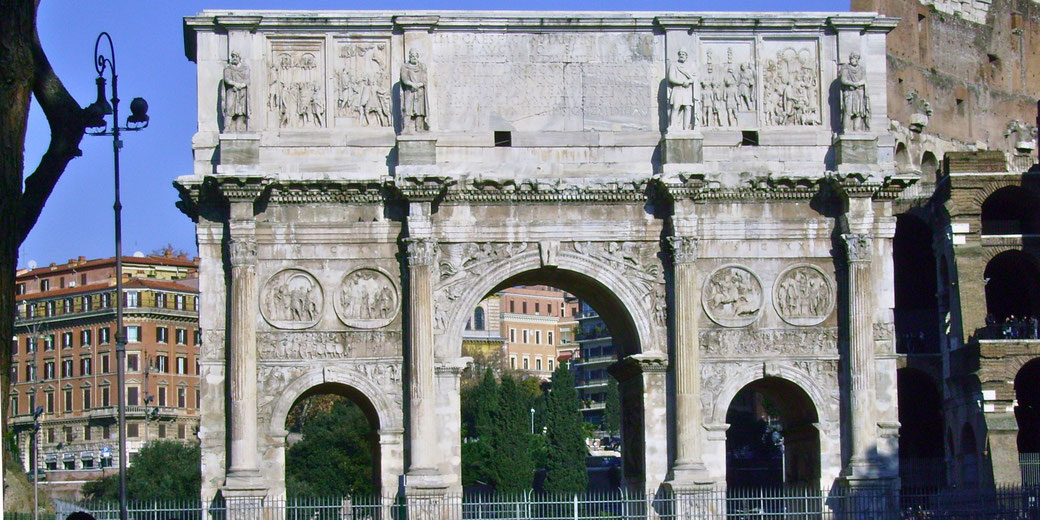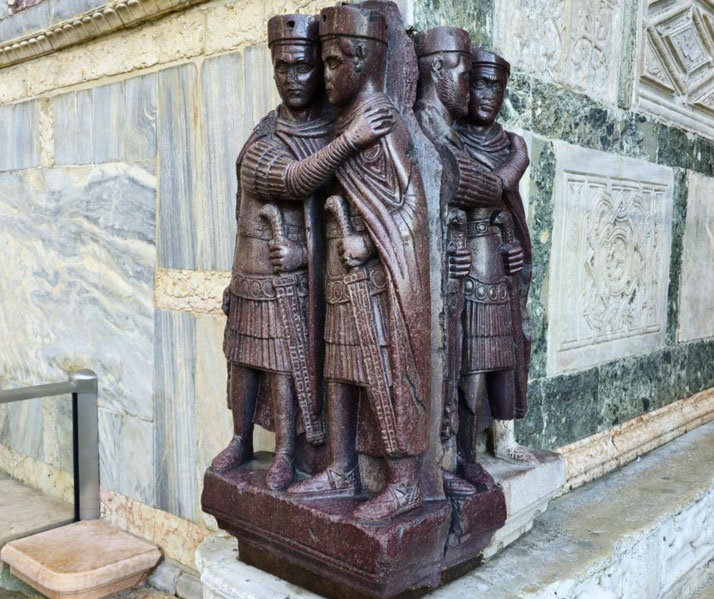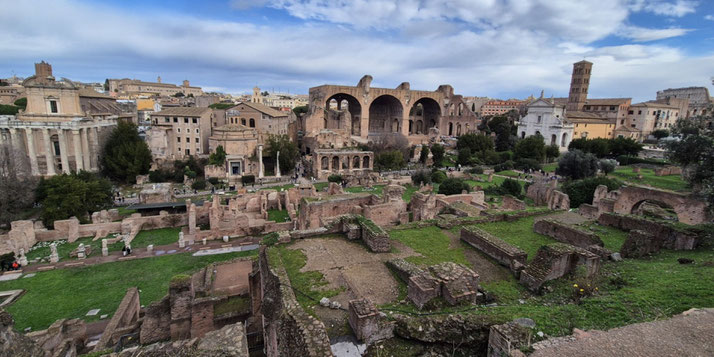Why did the Ancient Roman Empire decline?

The fall of the Western Roman Empire in the 5th century AD is one of the most studied and written about topics in European history.
However, it didn't collapse overnight. In fact, there were several centuries of slow decline that introduced a series of crises that led to its final fall.
While there are many theories out there as to why the Roman Empire eventually fell, there was no single, definitive, cause.
Instead, there were a number of contributing factors that worked together to cause its decline.
Background: The Roman Empire at its height
The Roman Empire had experienced a 'golden age' during the 1st and 2nd centuries AD, which was driven by military expansion.
This began with the first emperor, Augustus, and continued with the rest of the Julio-Claudian emperors and the Flavian dynasty of emperors that followed them.
In the second century AD, the empire reached its greatest extent in AD 117, under the rule of emperor Trajan.
It covered an area that extended from Britain in the north, Spain in the west, North Africa in the south and the fertile crescent in the east.
This vast empire was protected by 30 legions, which were spread around the border of the Roman territory to both prepare for further expansionist wars, but to also suppress any local rebellions.
As a result, the legions were often concentrated in the most troublesome regions, while provinces that were peaceful rarely had legions stationed within them.
Since a legion totalled around 5,200 men, it means that around 160,000 legionaries were in charge of protecting the entire empire.
Even though they were supported by an additional 150,000 auxiliary soldiers, this was still not a large number of men for such a vast territory.
By the time of the mid-2nd century AD, the cost of paying this many permanent soldiers continued to rise, and the Roman state could not afford to be in a constant state of war.
Therefore, the role of the legions focused more on defending their current borders rather than extending them.
Unfortunately, without the income produced by new wars, there was less money being earned by the Roman empire to keep paying the legions.
This mix of economic and military pressures could have been maintained in a delicate balance, as long as there were no sudden changes or emergencies that hit the Roman world.
In fact, for the second half of the 2nd century AD, things generally stayed the same.
However, the 3rd century would see a series of dramatic events unfolding in the Roman world that would bring the empire to its knees.
The causes of the crisis
During the late 2nd century and early 3rd century, the Roman empire came under constant pressure from aggressive 'barbarian' tribes beyond their borders.
As a result, the legions spent their time fighting off invaders. However, the legions could not be everywhere at once, and often bands of warriors crossed the borders and attacked the important farmlands of the empire.
This caused economic stress, since most internal income of the empire came from agriculture.
As more farms were attacked and destroyed, the more farmers felt unsafe, which meant that the farms were increasingly left unrepaired.
This resulted in less revenue being produced to pay the legions.
The legionaries themselves also became unhappy. Fighting constant defensive battles meant less glory and money for them personally.
It also become increasingly more dangerous to be in the army when they did not know when and where the next attack would come from.
Consequently, the legions expected more pay as their work became more dangerous.
As each new Roman emperor took the throne, the soldiers demanded a pay increase.
Unfortunately, as less money was being earned, the less emperors could offer them.
The only other source of income the emperors could have relied upon was trade: when businesses bought goods in one province of the empire and made money when they sold it in another.
The empire itself made an income from this process by charging taxes on the buying and selling of goods.
The more merchants made in their businesses, the more the empire did as well.
However, with increased uncertainty when travelling in the countryside due to barbarian attacks, the less likely businesses were to engage in trade.
A merchant could spend his money buying goods in one province and lose it all in a barbarian attack on the way to sell it.
If the merchant escaped with their lives, they would still have lost their money and their products.
In this uncertain climate, less trade was conducted and, as a result, the empire made less money in tax revenue.
The Crisis of the 3rd Century
The combined economic and military pressures culminated in the event known as the 'Crisis of the Third Century'.
This was a period of time between AD 235 and 284 which saw the Roman Empire nearly collapse.
It began in AD 235 when the Roman emperor, Severus Alexander, was attacked and killed by his own soldiers.
Severus had failed to give the legions the pay rise they demanded since he was unable to find enough cash to meet their demands. In retaliation, he had been assassinated.
For the next 50-years, the Roman empire fell into chaos as civil wars broke out between people who sought be emperor.
During this time, over 20 separate people would rule the empire, with many of them being killed by the next one.
This produced constant political stability which, when combined with the collapsing economy, also saw increased barbarian invasions of Roman territory.
The empire shatters
After two decades of devastating civil wars, constant political change, and increasing poverty around the empire, a number of Roman provinces decided that it was in their best interests to separate from Rome and focus on their own survival.
In AD 260, the governor of Germania, known as Postumus, formed his own empire, called the Gallic Empire.
It included the regions of Germania, Gaul, Hispania, and Britannia. These provinces had been the focus of many barbarian incursions and Postumus was frustrated that not enough money had been spent on the defense of his territories.
In a similar way, in around AD 270 Queen Zenobia of Palmyra in Mesopotamia founded her own empire, called the Palmyrene Empire.
The city of Palmyra was a wealthy trading centre, and it had been calling for greater safety for economic activity, which Zenobia had thought had been ignored for too long.
She quickly expanded militarily by invading other Roman provinces and eventually captured Syria and Egypt.
Rise of Aurelian
The various people who claimed to be the Roman emperor during the crisis years paid little attention to the fragmentation of their lands into the new empires. They were too focuses on seizing and holding onto their power.
However, with the rise of a capable military commander and administrator, the empire tried to save itself.
This man was called Lucius Domitius Aurelianus ("Aurelian"). Aurelian had been a cavalry commander who had served under, and was instrumental in overthrowing, three successive Roman emperors. He then seized the throne for himself.
Aurelian turned his focus to stabilising the empire. Between AD 270-2, he launched successful military campaigns to drive back the Germanic tribes of the Vandals, Alamanni, and Juthungi from Roman territories.
Reuniting the empire
With increased security in the empire, Aurelian turned his attention to bring the break-away empires back under his control.
First, he marched his forces east to deal with the Palmyrene Empire. He defeated Zenobia at the battles of Immae and Emesa in AD 272.
The city of Palmyra was recaptured, and Zenobia was taken prisoner.
Next, Aurelian marched west to deal with the Gallic Empire. By the time he arrived in around 273, Aurelian had learned that Postumus himself had been killed by his own soldiers in 269.
The empire was now led by Tetricus I. At the Battle of Chalons in 274, Aurelian won a decisive victory.
Following the defeat, Tetricus I surrendered and was allowed to live, but the Gallic empire was reabsorbed back into Aurelian's territories.
With the reunification of the empire, Aurelian had been able to demonstrate that the Roman empire was still alive and well.
However, the causes of the crisis still existed, and Aurelian needed to constantly be on the move to deal with ongoing problems. Aurelian himself would die in 275 when he was killed by his own soldiers.
It appeared that the empire was about to once more descend into chaotic civil war, as up to six different men would become emperor over the next ten years.
Finally, another strong leader appeared that would finally bring the crisis to an end. His name was Diocletian.
The reforms of Diocletian
Diocletian was born around AD 245 near Salona, in modern day Croatia. He came from a humble background and worked his way up through the ranks of the military before becoming emperor in AD 284.
He was known for his military reforms and administrative abilities, which helped to stabilize the empire after a period of instability due to invasions by barbarians from outside its borders.
Diocletian attempted to solve the ongoing crises by dividing the empire into two parts, each ruled by a co-emperor.
He realised that one man could not be 'everywhere at once' in order to successfully deal with each problem as it arose.
By splitting his territories into two regions, each with a person in charge, he could create a far more efficient way of running the empire.
Diocletian himself took control of the eastern half of the empire, while another man, called Maximian, was given control of the west.
Each of these emperors were referred to as an 'Augustus'. Each Augustus would then assign an heir to their position called a 'Caesar'.
The idea was that the Caesar would be 'in training' and take over when the Augustus' time in power ended.
The existence of two Augusti and two Caesars created a situation where four people held power in the Roman Empire. This is why this is referred to as the Tetrarchy.
Diocletian also created an efficient bureaucratic system that allowed for better communication between officials throughout the empire, making sure things ran smoothly on all fronts.
Diocletian is often credited with saving the Western Roman Empire from collapse by implementing these reforms during his reign as emperor until he retired in AD 305 because he felt it was time to pass on his responsibilities.
Diocletian's tetrarchy did not last long however, and in AD 310 Constantine I would reunite them under his rule as sole emperor.
Constantine I then moved the capital from Rome to Constantinople, which was closer to his new territories in Asia Minor and more easily defensible against invaders coming down through Europe.
However, at the time, Diocletian's idea seemed to be the best solution for long-term stability.

What happened after Diocletian?
The Germanic tribes continued to play a role in the economic decline of the empire.
Various tribes had crossed the border into the empire seeking land and resources, which put a strain on the empire's resources.
However, after being rejected by the Romans, the Germanic tribes instead wanted to attack towns and take as much as they could. This led to conflict and instability within the empire.
At the Battle of Adrianople (which took place near modern Edirne) in AD 378, the emperor Valens was killed, along with 20,000 Roman soldiers who were defending against invading Goths.
This battle marked a turning point for the empire; it showed that Rome could no longer defend itself against these barbarian tribes.
In AD 410, the Visigoths, who were a Germanic tribe, sacked Rome – an event which shocked the Roman citizens and showed them that their empire was not invincible after all.
This led to a period of instability and decline for the Western Roman Empire.
The barbarian leader Odoacer is another important figure in the fall of the Western Roman Empire.
He was a Germanic military leader who led his troops into Italy in order to overthrow Romulus Augustus, the last emperor of the Western Roman Empire.
Odoacer then ruled Italy as its first king, rather than as emperor, from AD 476 until his death in AD 493.
The eastern Roman empire
The Eastern Roman empire would survive for another 1000 years after the fall of the western half of the Roman empire.
A new capital was founded at Byzantium, and so the eastern empire became known as the Byzantine Empire.
The capital would quickly be renamed Constantinople and would survive until the middle of the 15th century.
What caused the fall of Rome?
In conclusion, the fall of the Western Roman Empire was a complex process that involved many factors such as economic decline, military invasions by barbarians from outside its borders, and political instability.
It was a gradual process that culminated in the year AD 476. This date has therefore become the traditional date for the end of the Roman empire in the west.

Further reading
What do you need help with?
Download ready-to-use digital learning resources
Copyright © History Skills 2014-2025.
Contact via email
With the exception of links to external sites, some historical sources and extracts from specific publications, all content on this website is copyrighted by History Skills. This content may not be copied, republished or redistributed without written permission from the website creator. Please use the Contact page to obtain relevant permission.





